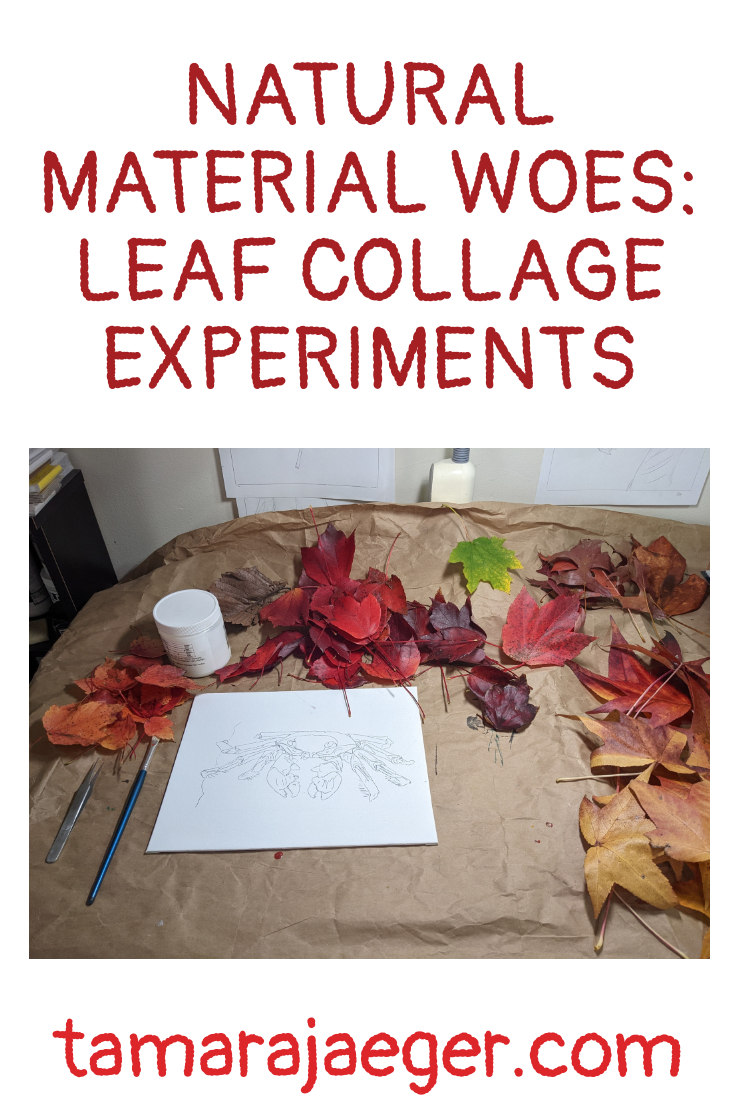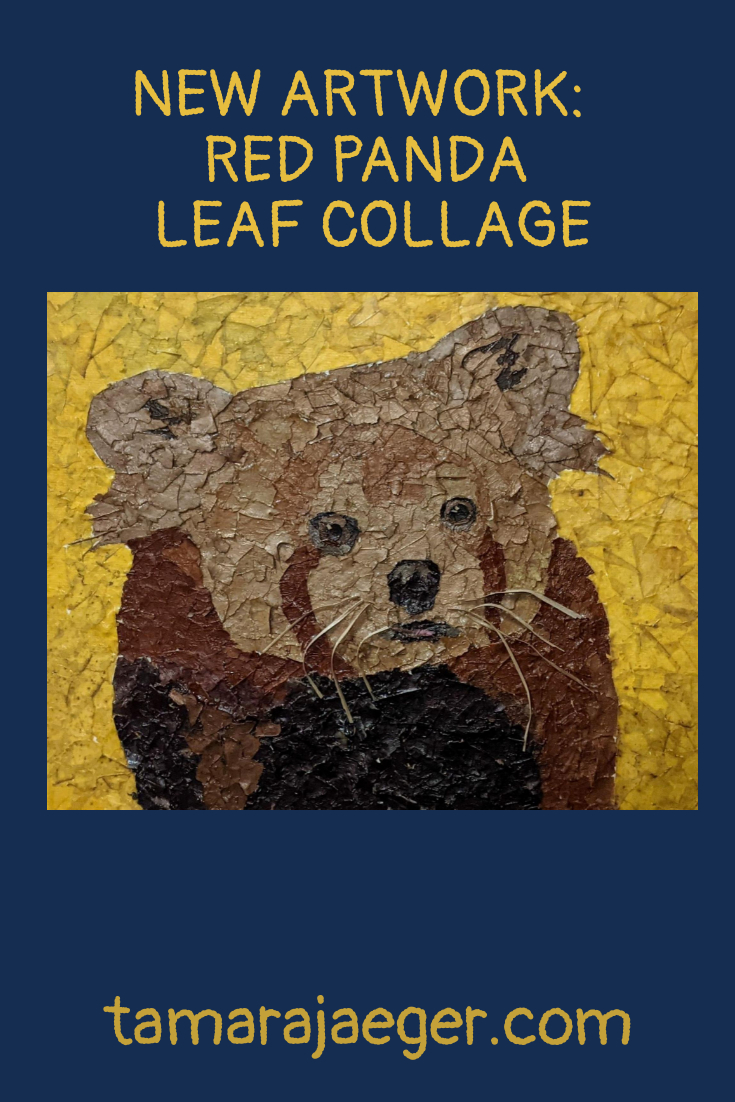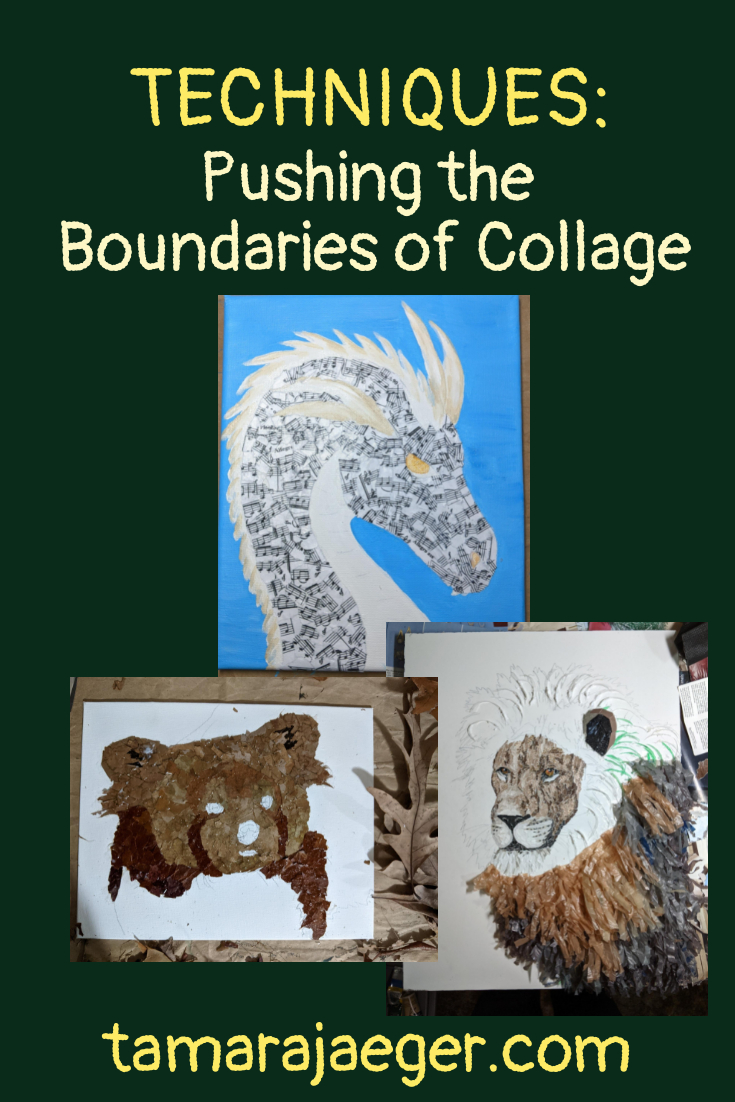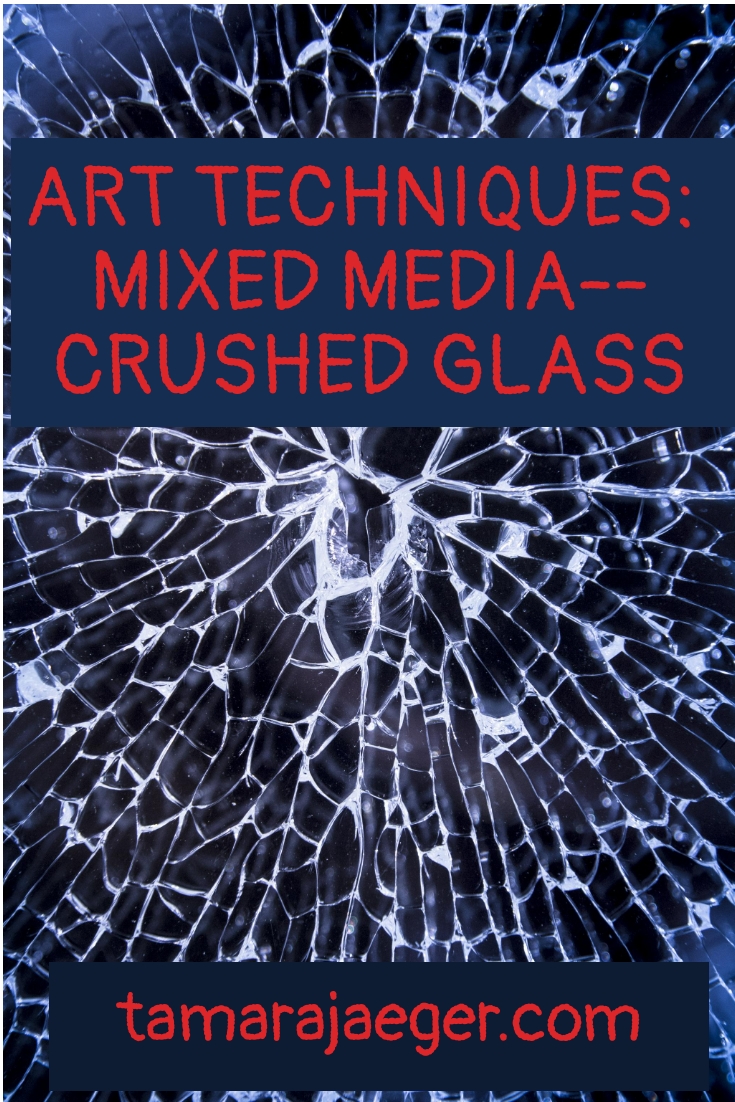Posts Tagged: mixed media


Natural Material Woes: Leaf Collage Experiments
I wrote previously about an experiment I did using leaves to make a collage. If you missed it, you can find the post here.
A year later, I know you’re all wondering, “How is the Red Panda leaf collage looking now?”

Well, actually not too bad. Most of the piece still looks pretty much the same as it did when it was first made. The only noticeable change is that the color of the yellow leaves in the background has faded. While that’s not ideal from an aging/longevity standpoint, aesthetically I’m not exactly crushed. I didn’t really like the super bright yellow color it had originally, so this more muted yellow is a bit nicer to look at.
I suspect it’s at least partially due to the yellow leaves being a bit ‘fresher’ than the brown ones, so the color wasn’t as stable. This, of course, begs the question: How will red, orange, or green leaves hold up over time?
This is definitely something that needs looking into! So, I created another experimental test piece, using red and green leaves, to see how those colors will age.

Here we have a red crab from the Galapagos islands. I thought he was pretty cool-looking and he had the right colors, so he was my test victim. I suspect I should have used a subject that had larger areas of red, like a cardinal, but oh, well! I’ll keep you posted on how this one ages as well.
If you’re curious about the materials I used (other than leaves!), here’s a list:
*Golden Acrylic Soft Gel Medium
*Winsor & Newton Galeria Acrylic Satin Varnish
I’m thinking of trying out flowers as a medium for collage as well. What do you think?
Want to stay up to date and see more of what I’m working on? Sign up for my mailing list here and get a FREE digital download of an exclusive tiger linocut print. (I promise not to be spammy with my emails—I hate that too!)
* Please note that this post contains affiliate links and any sales made through such links will reward me a small commission – at no extra cost for you.


New Artwork: Red Panda Leaf Collage
Here’s another new piece. It’s actually an experiment. I have No idea how it will hold up over time!
Based on an off-hand comment from a friend about a photo I took of my dog sitting in a patch of leaves, I decided to see if it was possible to create a collage out of leaves! It’s just another material, right? Kind of like the magazines and catalogs I usually use. But different…

Anyway, I created this collage of a Red Panda using just fallen leaves that I collected in my neighborhood. I’m not entirely thrilled with the bright yellow background, but it was kind of at the end of the season, so there weren’t many non-brown colors left to choose from! White is also quite tricky to come by. I settled for a pale tan. It kind of gives the whole piece and ‘aged newspaper’ look that I think I like.

Leaves are definitely a tricky material to work with. When they’re fresh, they’re flexible and easy to tear. The next day, they’re all dried out and crispy and nearly impossible to work with! I may try keeping them in a sealed plastic box or bag to keep them flexible. Possibly in the fridge, so they don’t start to mold. Fresh, ‘green’ leaves are also something I might test out. It’s definitely a material I plan on exploring further.
Since this was a ‘test,’ it’s a little smaller than I usually make my collages and isn’t quite as detailed. I really just wanted to see how well leaves would work for collage and how well it holds up over time. I used an 8” x 10” canvas panel and my go-to “adhesive,” Golden Acrylic Soft Gel Medium. I coated the piece with Winsor & Newton Galeria Acrylic Satin Varnish to help protect the leaves (and hopefully the colors).
What do you think of the result? I’ll keep you posted on how it ages over time.
Want to stay up to date and see more of what I’m working on? Sign up for my mailing list here and get a FREE digital download of an exclusive tiger linocut print. (I promise not to be spammy with my emails—I hate that too!)
* Please note that this post contains affiliate links and any sales made through such links will reward me a small commission – at no extra cost for you.


Pushing the Boundaries of Collage
I’ve been working on a lot of pieces lately that combine other materials and techniques with my ‘normal’ torn paper collage. Part of it is just to see how far I can push things. I’ve gotten my torn paper collage technique quite well-refined, to the point that the paper pieces function more like paint or another traditional medium than as collage. There’s certainly nothing wrong with the traditional collage look, but that’s not where my journey has taken me!

Part of it is a natural progression. A lot of my ‘paintings’ have shifted to be more abstract, mixed-media pieces that are increasingly three-dimensional or other wise not contained to a single, flat plane. There are pieces that are formed from multiple canvases and pieces where the ‘image’ doesn’t stay within the rectangular boundary of the canvas. It makes sense that my collages would evolve too, I suppose.
The Inspired Art piece I talked about here was definitely a jumping-off point. There’s still some of my usual torn paper collage, but it also includes a lot of non-standard materials. “Trash,” used as an art medium. The little test collage of a Red Panda I made out of leaves (you can read more about it here) was another interesting side branch and one that I think I’ll explore further. I suspect there are definite limits to what can be accomplished with leaves as an art material. But I really want to see what those limits are!

All this experimentation and exploration means that I’ve needed to adjust the materials and techniques I use, however. Normally, I use artist’s drawing paper and scrapbooking glue to attach paper fragments torn from catalogs and magazines. I intentionally use paper as a substrate, since it will respond the same way the collaged paper fragments will to changes in temperature and humidity. It’s the conservator in me! I also don’t varnish my paper collages, since the varnish is not removable and even archival-quality varnishes will yellow over time.
With the pieces that contain other materials, there are different concerns. The variety of materials means that there will always be a potential issue with how the different parts of the piece respond to changes in environment. I use a sturdier substrate, like a wooden panel, since the materials can sometimes be quite heavy, relatively-speaking, so they need more support. I use different materials as the adhesive, since scrapbooking glue isn’t strong enough or ‘bulky’ enough to hold the different materials firmly.

I also tend to use varnish more often, either on the entire piece or just on parts of it. This is to help protect the materials themselves, either from humidity changes or from the other materials. I coat the metal pieces to keep them from rusting, for example, which could damage parts of the piece that are in contact with it. The varnish also helps to give the surface a more uniform; something that’s not really an issue when I working just with paper.
Some of the materials I’ve been using in my mixed-media collages are listed below, if you are interested in my go-to products.
- Golden Soft Gel Medium
- Golden Light Molding Paste
- Winsor & Newton Galeria Acrylic Satin Varnish
- ZIG or EK Tools 2-Way Glue
- Strathmore Drawing Paper
Want to stay up to date and see more of what I’m working on? Sign up for my mailing list here and get a FREE digital download of an exclusive tiger linocut print. (I promise not to be spammy with my emails—I hate that too!)
* Please note that this post contains affiliate links and any sales made through such links will reward me a small commission – at no extra cost for you.


Art Techniques: Mixed Media: Crushed Glass
One of the materials I’ve found useful and interesting when working on my abstract mixed media pieces is crushed glass. It’s not a typical art material, so it can be difficult to get a hold of at a good price. I often find it in stores that sell home décor items—usually in the aisle with the vase fillers and candles. Sometimes I even get lucky and find some at the dollar store!

Generally I will use crushed glass when I’m trying to add a thick, sharp, chunky texture to a piece, though it’s also useful for it transparency in certain situations. In my “Below the Surface” series, I used crushed glass in a number of pieces, since the inspiration for the series was rocks, minerals and geological features. The glass makes good ‘crystals’!

In Glacier, I wanted the clear, translucency of the glass to remain, to simulate ice crystals, so I attached it directly with my trusty acrylic soft gel medium, which wrote about previously here. Geode was similar, but I used a blue-tinted glass instead of clear. A difficulty with this method is that no matter how much soft gel medium
you put down first, there will always be some glass pieces that didn’t stick well and fall off when you move the piece.
Crushed glass can also be used more for the texture, which is how I used it in Cave 1 and Crevasse. In these pieces, I attached the crushed glass by sprinkling it over a thick layer of soft gel medium, but then I used acrylic paints thinned with pouring medium
the top of the glass. This gives me the coarse texture without the translucence and also helps to make sure the glass fragments are securely attached to the canvas.


Other potential drawbacks to using crushed glass are the sharp glass fragments than can get scattered over the floor. I tend to work in my studio barefoot, so this can be hazardous. Though admittedly, most of the glass pieces aren’t lethally sharp or anything. I’ve never actually gotten one stuck in my foot, anyway. They’re still not too comfortable to step on. The glass also can add quite a bit of weight to the finished piece, depending on how much glass is used. Kelpie, from my “Elementals” series, for example, is heavy enough that it needs a pretty sturdy hanger to keep it on the wall. I was using those 3M Command Picture Hanging Strips in my previous apartment and I think it took 4 strips before the piece stopped falling off the wall. (Also, if you haven’t tried 3M Command Strips
, they’re Awesome. Especially in a rented apartment where you can’t or don’t want to put holes in the wall.)

What unusual materials have you used in your art? Are there any materials you’ve seen somewhere and thought “Hey, that might look pretty cool in my artwork”? Tell me in the comments; I’d love to hear about it!
* Please note that this post contains affiliate links and any sales made through such links will reward me a small commission – at no extra cost for you.